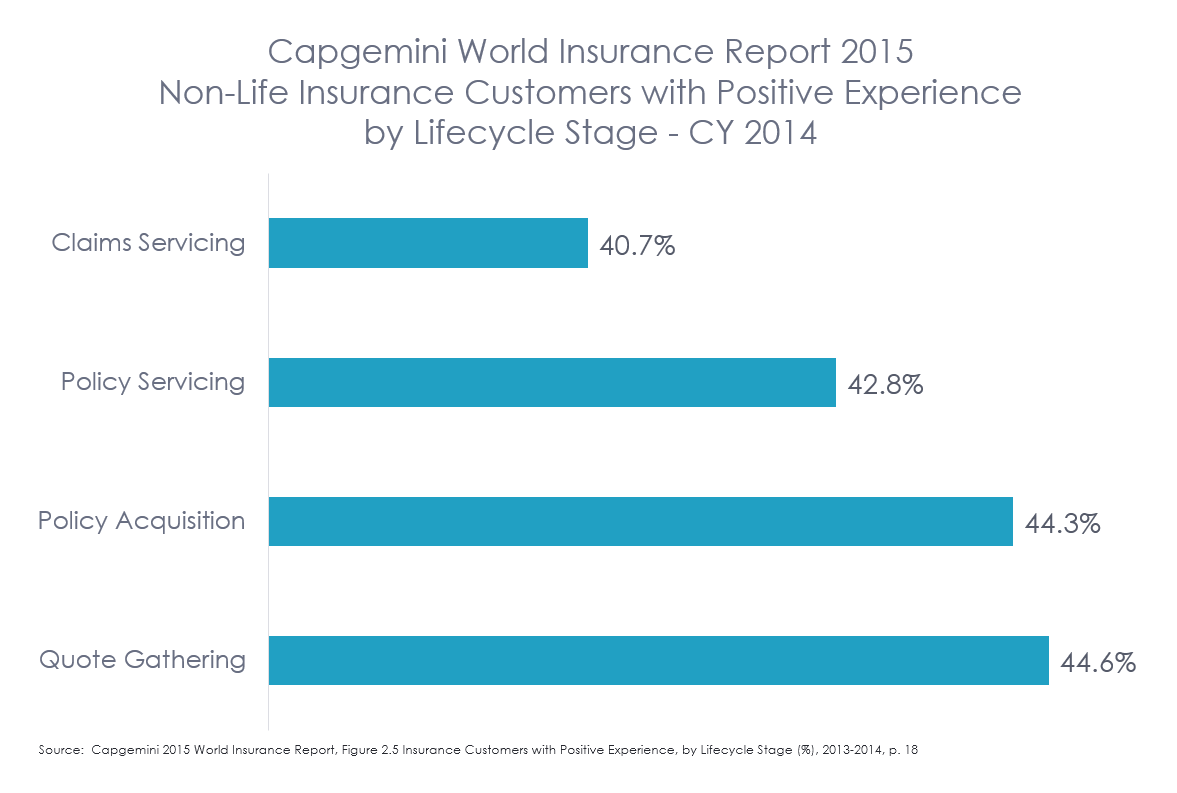
(This article was featured in Property Casualty 360.)
Why A Good Claim Experience is So Important
Wikipedia lists “customer satisfaction” as “… a measure of how products and services supplied by a company meet or surpass customer expectation.”1 Companies have used this metric for many years, with numerous studies drawing correlation between a company’s ability to deliver customer satisfaction and reap improved economic returns.2
Customer satisfaction has long been recognized as a critical performance metric for the insurance industry. The average customer has numerous touch points or interactions with their insurance company. Capgemini’s World Insurance Report 2015 found that throughout the insurance lifecycle, claims servicing had the lowest percentage of customers with a positive experience.3
The Capgemini data also shows that customers with an insurance claim often had lower positive experience levels overall than those with no claim.4 In North America CY 2014, only 37 percent of the customers surveyed by Capgemini reported a positive experience with auto insurance if they made a claim in the past year, versus 46 percent of customers who made no claim during that same period.5
Novarica’s study, “Business and Technology Trends in Claims,” released in July 2015, reported “… claims management continues to be an area for strategic innovation as technology allows carriers to increase efficiencies, deliver a better customer experience, and glean new insights through easier access to data.”6
So how do carriers and collision repairers take a negative event, like an auto accident, and help make the final outcome one where the customer is not only happy with the repair of their vehicle, but is willing to share with others just how well the experience with the carrier and the collision repairer exceeded their expectations? How does technology facilitate this? In this article we will look specifically at the experience of a vehicle repair, and the factors that drive customer satisfaction with this critical part of the auto claims process.
What Drives Customer Satisfaction with the Vehicle Repair?
To understand the key factors that drive customer satisfaction for customers that have filed an insurance claim and are having their vehicle repaired, analysis of customer satisfaction survey data was conducted by CCC’s Analytics team using data collected from CCC ONE® Update Plus customer satisfaction surveys.
For reference, the CCC ONE® Update Plus CSI survey asks questions designed to understand the variables driving customer satisfaction. A single question survey regarding the “Overall Experience Score” is sent immediately following vehicle pickup, then followed by the multi-question survey, which asks additional questions about the customer’s repair experience, such as quality, service, whether the customer was kept informed, whether the vehicle was ready when promised, and whether the customer would recommend the collision repairer and carrier.
Summary of Analysis of Customer Satisfaction Data
The CCC Analytics team conducted analysis on the CCC ONE® Update Plus CSI individual surveys that included both the single question survey on “Overall Experience” and the multi-question survey from January 2014 through October 2015.
The analysis looked at the impact of each individual survey question independently and its correlation to a positive or negative “Overall Experience.” Results were then independently validated using a classification statistical model. Analysis of individual collision repairers’ aggregate CSI results yielded similar results.
Observations:
- Responses to the quality and service questions are the key indicators for Overall Experience and the likelihood the customer will recommend the collision repairer. In other words, higher scores for the quality and service survey questions have clear correlation to a better overall customer experience at a repair facility.
- Keeping customers informed during the repair process also helped drive positive Overall Experience. In 98 percent of the survey responses where the customer provided a quality score of more than 8, they confirmed they were kept informed during the repair process.
- If customers had to return a vehicle for additional work, it negatively impacted their overall experience.
- The keys to keys cycle time of a repair does not influence the customer experience. Whether a vehicle took more time or less to be fully repaired and delivered to the customer has negligible correlation with the customer’s experience compared to other variables.
- A positive response to the overall experience has a direct correlation with the customer recommending the repair facility.
Historically, the accepted belief in the industry was that cycle time was a key factor driving customer satisfaction. The results of this analysis would suggest otherwise.
Instead, while cycle time is still important to both the carrier and collision repairer, the quality of the repair, customer service and managing customer expectations by keeping them informed throughout the repair are what customers value the most.
How Technology Plays a Part
Many collision repairers today are using technology to “digitize the customer journey”7 through the vehicle appraisal and repair processes. This technology not only offers consumers an experience they have come to expect, by automating many of the manual steps needed to keep the customer informed throughout the repair, but it also frees up the collision repairer’s time so they can focus on the actual repair of the vehicle and still provide the customer with the service they expect.
Customers’ experiences downloading music, or ordering good and services online have shaped their expectations. Customers now expect businesses to provide transparency into the buying experience, preferably via digital means.
A recent study by McKinsey & Company, “Speed and scale: Unlocking digital value in customer journeys”, discusses that companies that want to win at digital adoption, “…must digitize entire ’customer journeys.’” These are the beginning-to-end processes that customers experience in getting the product or service they need, across whichever channels they choose.”8
The ability to greet the customer at the door, write the appraisal at the vehicle with a tablet, schedule the repair, and then set up automatic updates to the customer on the status of their repair throughout the vehicle’s time in the shop, ‘digitize the customer journey’.
Subsequently, the quality of the experience is driven not only by this expectation met, but also by the quality of the repair and service provided by the repairer.
Sources:
[1] https://en.wikipedia.org/wiki/Customer_satisfaction.
[2] Eugene W. Anderson, Claes Fornell, Donald R. Lehmann. “Customer Satisfaction, Market Share, and Profitability: Findings from Sweden.” Journal of Marketing, Vol. 58, No. 3 (Jul., 1994), pp. 53-66. https://www0.gsb.columbia.edu/mygsb/faculty/research/pubfiles/927/927.pdf.
[3] Source: Capgemini 2015 World Insurance Report, Figure 2.5 Insurance Customers with Positive Experience, by Lifecycle Stage (%), 2013-2014, p. 18.
[4] Ibid.
[5] Ibid.
[6] Bacheldor, Beth. “Tech and Customer Expectations are Transforming Claims Processing.” Insurance Networking News, July 23, 2015. www.insurancenetworking.com.
[7] Driek Demet, Shahar Markovitch, Christopher Paquette. “Speed and scale: Unlocking digital value in customer journeys.” McKinsey&Company Operations, November 2015.
[8] Ibid.
